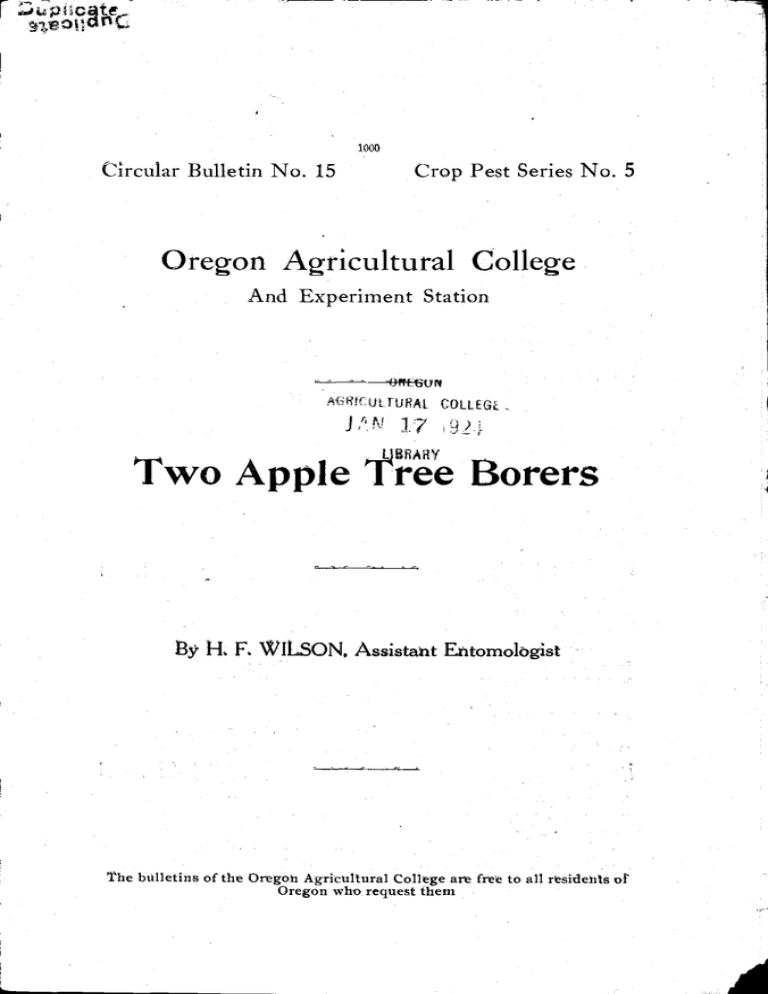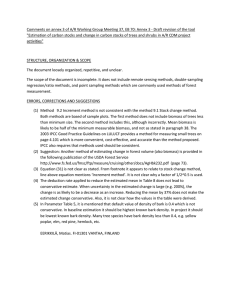Two Apple Tree Borers Oregon Agricultural College t 17
advertisement

r t 1000 Circular Bulletin No. 15 Crop Pest Series No. 5 Oregon Agricultural College And Experiment Station ut fUHA COLLEGE 17 LBAY Two Apple Tree Borers By H. F WILSON, Assistant EitomoIgist The bulletins of the Oregoh Agriceltural College are freC to all rsidehls of Oregon who request them .3 TWO APPLE TREE BORERS H. F. WILSON. Of the two species given, the "Flat-Headed" apple tree borer (Chrysobothris femorata Fab.) and the "ROund- Headed" apple tree borer (Saperda candida Fab.), only the first is at present known in Oregon. However, since the second species is ordinarily the more serious in the Eastern states and may appear here at any time, it is thought well to give an account of it. THE FLAT-HEADED APPLE TREE BORER. (Chrysobolhrisfemo,'ata.) The records of the Entomologists at the Oregon Agricul- tural College show that there has been reported injuries of this species in Oregon for the last fifteen or twenty years, and that these injuries are principally upon two or three year old trees. With the large number of young trees which have been set out during the past few seasons, these reports have grown more numerous, and a considerable number of trees have been reported as killed. NATURE AND EFFECT OF INJURY. Usually the fruit grower notices that some one or more trees planted the previous season appear unthrifty. Upon examination, the trees are found to be attacked, at a point near the surface of the ground, by a long, flat, broad-headed worm, which has worked along under the bark cutting a long channel and usually girdling the trees. The place of infestation may be detected by the discolored bark covering the tunnel made by the borer. GENERAL APPEARANCE AND HABITS: The adult of this insect is a greenish, metallic brown beetle measuring about a half-inch in length. The body above is flattened, and in fresh specimens is coated with a grayish powder. The under side of the body is bronze colored. The adults come out in the Spring, and after mating, the females begin laying eggs upon the bark; and the forthcoming larvae bore into the bark, excavating a broad burrow just under the outside layer. The broad heads of the larvae cause the necessity of a wide burrow, and as the insect grows the channel is made wider, so that finally it may be threeeights of an inch or more in width. The larvae continue feeding throughout the Summer and when full grown bore directly into the sap-wood of the tree, pupate, and, remaining there until Spring, come forth as adult beetles. Reports of injury usually come in the Fall of the year, as it is then that the insect has finished its work and the tree begins to show the effect of the injury. In the case of large trees the insect probably goes deeper into the wood from the beginning where it feeds and lives until ready for pupation. In other sections of the United States it has been reported as working mostly in the parts of the tree ranging from the base of the trunk to the limbs. There seems to be a difference of opinion regarding the health condition of the trees attacked, but in Oregon the first signs of trouble appear as a result of the damage caused by the insect itself. Besides the apple, a number of other trees are attacked, as the pear, peach, prune, and some snade and forest trees. METHODS OF CONTROL: Clean culture should be thoroughly practiced, and nurseries should not be located near infested orchards. When a tree seems to be injured beyond recovery it should be removed and burned so as to get any larvae or pupae which may be present in the infested tree. Perhaps the most prevalent methods are mechanical barriers. These may be defined as something placed about the trunk of the trees so that the adults cannot lay their eggs upon the bark. Newspapers or untarred building paper will do for this purpose, if bound with string and tied at top and bottom so as not, to permit the beetles crawling under. The string used should be such that the expansion of the tree can break it, should the growth be excessive. Window screen may be used, but must be placed far enough away from the bark so that the eggs cannot be laid through the meshes of the wire. Cotton should be placed about the opening at the top so that the beetles cannot crawl under. In the case of any of these barriers, the dirt should be mounded up above the base of the tree so that the adults cannot crawl under them at the bottom. A good stiff whitewash containing crude carbolic acid and arsenate of lead should be applied to the trunks of the trees above the barriers. If the orchardist thinks these are too troublesome, perhaps the whitewash applied to the entire trunk will act as a deterrent. THE ROUND-HEADED APPLE TREE BORER. (Saperda candida.) It has been stated that this insect probably causes the death of more young trees than all other natural agents taken together. 4 In 1872 Mr. P. B; Wier, of Wisconsin, wrote that in hi opinion this pest is one of the worst attackmg fruit trees, and stated that it would probably destroy 5000 out of every 10,000 young trees within three years. A Mr. Powell, of Ghent, New York, is mentioned as hav- ing, in 1889, reported the removal of thirty grubs from a single tree. The first indication of the presence of the in sect is in the unthrifty appearance of the trees and the saw-dust like castings thrown back by the lar'cia whiëh fills up the burrow after it and tends to keep out such enemies as could et in that way. C'ose observation will show very distinctly the discolored bark above the borer. Where grasses and weeds are al- lowed to grow about the trunks, the injury is liable to be more severe, due to the concealment afforded th adult beetles LIFE HISTORY: The adult beetles make therr appearance in late Spring, and, flying:about at night, the females make incisions in the bark where they place their eggs and cover them with a thick gummy fluid. The egg is somewhat flattened, pale, rust-brown in color, and measures one-eighth of an inch long by about one-twen ty-fourth inch in width. The young larvae, soon after hatching from the egg, burrow through and under the bark, and, feeding In the sapwood, work their way upward and then downward. About three years are required for the full development of this species, and for the major part of that time it is in the larval stage feeding and developing through the Summer months and remaining inactive at the lower end of the burrow during the Winter. When mature, the larva burrows outward to the bark, constructs pupal cells and changes to the pupal form It remains in this stage for severai weeks, according to Dr.Chittenden, and then gnaws through the bark, forming a round onening through which it emerges The adult beetle is brown- ish in color with the antennae and legs a light gray. Along the back there are two white bands which run the length Of the body and are more widely separated at the middle of the back than at the ends. CONTROL MEASURES: The remedies used for the precedtng species will apply for this species, although it is ilot necessary to apply them as far up the trunk






